2004 VOLKSWAGEN GOLF warning lights
[x] Cancel search: warning lightsPage 285 of 444
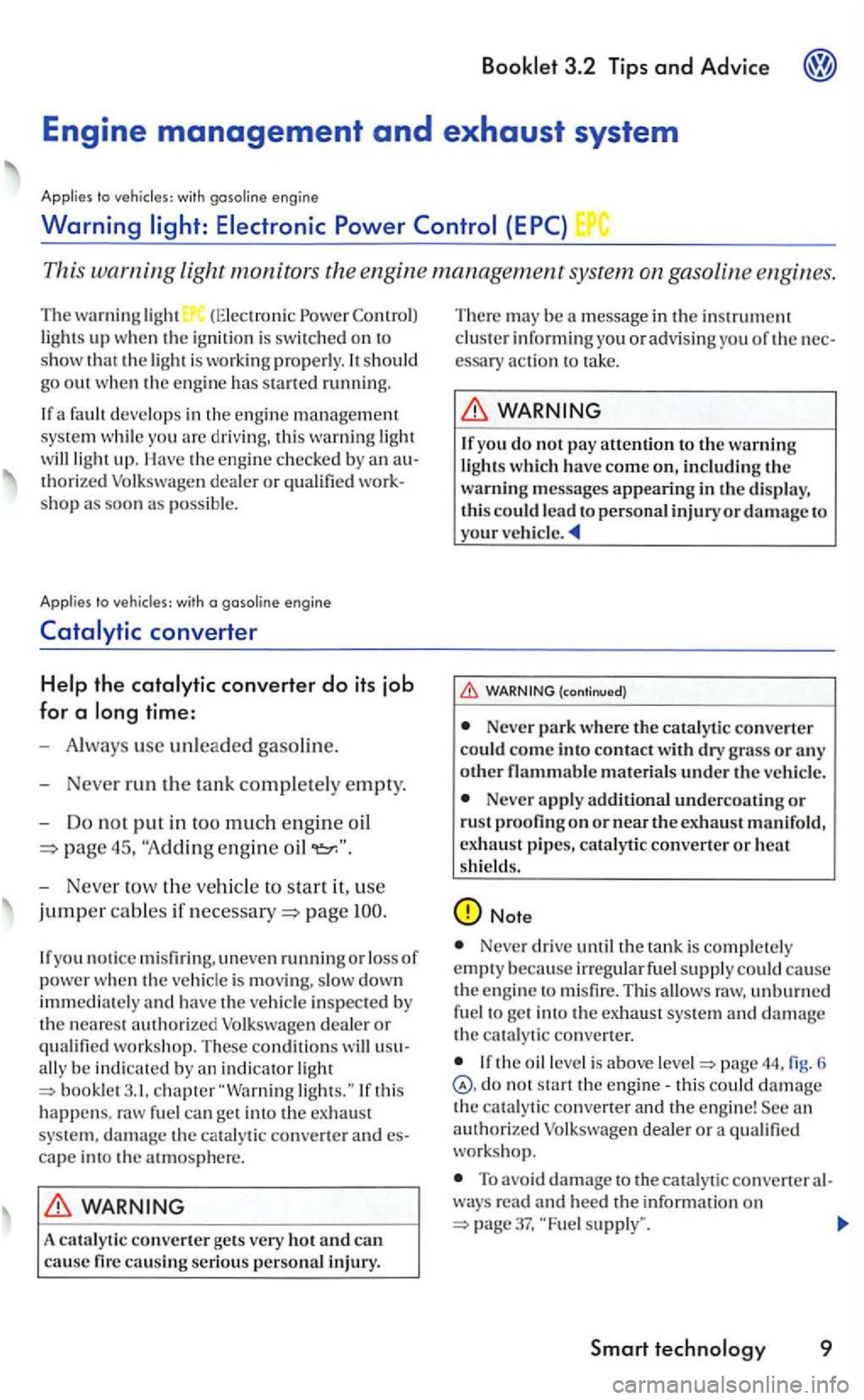
light monitors the
lights up when the ignit ion is sw itched on to
s how that the light is work ing properly. should
go ou t when the engin e ha s s tarted running.
a fault develops in the e ngin e management system while yo u are driving, thi s warning light
will light up. thorized dealer or qualified
the
t a nk completely empty.
- Do no t put in too much engine oil
45,
- Never tow the ve hicl e to sta rt use
jumper cables page
you notice misfiri ng, uneven running or loss of power whe n the vehicle is moving, slo w down
immedi at ely and have the ve hicle inspecte d b y the neares t authorized
chapter"Warning
cape int o the atmosphere.
A catalytic convert er ge ts very h ot and can
cause fir e causin g serious person al injury. Th
ere
may be a message in the in strument cluster inform ing you or advising you of th e essary ac tion to take.
yo u do not pay attention to the warning
li ghts which have come on, including th e warning messages appearing in th e d isplay, this could lead t o personal injury or damage to your vehic le.
(cont inued)
Never park whe re
Neve r apply additional undercoating or rust proofing o n or near the exhaust manifo ld,
ex hau st pipes, catalytic converter or heat s hi elds.
Note
Never drive until the tank is completely
e mpty becau se irregular fu el supply could cause the engine t o misfire. This allow s raw, unburned fu el to get into the ex haust sys tem and damage the catalytic conve rter.
the oil leve l is above page 44, fig. 6 not start the engine- t his could damage the catalytic co nverte r and the engine!
To avoid damage to the catalytic converter
37,
Page 287 of 444

3.2 Tips and Advice
This warning light is part of the On-Board-Diagno stic System
The MIL is a required indicator
assure you that th e MIL is workin g properly.
If the Malfun ctio n (MIL )
does n o t go out after th e eng in e is s tarted, or if it comes on w hil e yo u are driv ing, th ere is a mal
function in the engine sys te m.
If
the lamp starts blinkin g. th e catal ytic converter could be damaged . T he re m ay be sag e in the in strument clu ste r informing yo u or
advis in g you of the necessa ry action to take.
(DLC) for On-Board-Diag
nostic
The O n-Board-Diagnost ics in mon
itor s the vario us components of your e mission
control system. Each controlled component in y
our ve
hicl e has been coded. In case of functio n the respective component in questio n
will be identi fied and the fault stored in the form of a code in the control module's memory.
The stored data can only be d isplaye d wit h spe
cial testing equipment (generic scan tool for di agnosis.
To c
onnect the speci al tes ting equipmen t, push the p lug into th e Da ta Link locate d to the rig ht of the release for engine
h oo d.
Your
authorize d Volkswagen dealer or quali fied
wo rkshop can interpret the code and m ake the ne cessar y correction.
you do not pay attention to the warning
lights whi c h have come on, including th e warning messages appearing in the display , this could lead to pers o n al injury or damage to your ve hicl e.
Smart
Page 316 of 444

WARNING (continued)
Never reach into the area around or tou ch the radiator fan. Contact w ith the blade s can resuh in se riou s personal injury. Always m ember that the radiator fan is controll ed and can turn on
m oved from the ignit ion.
Never unscrew the coolant expa nsio n tank cap when th e engin e is hot. A hot engine will heat the coo la nt and put it under pressure . mov in g a cap that i s under pressure ca n rcsuh in seriou s personal injury and/or burns.
A lway s prote ct face, hand s and arms from hot esca ping coolant or steam b y cove ring the ca p with a large, thick rag.
Turn the cap slow ly a nd very carefully in a
counter- clo ckw ise direction whil e applying
light downward pressure on the top of the cap.
Never spill on hot engine parts o r hot
e xhau st sys te m . S pilled
Neve r short-circuitthc elec trica l sys te m ,
es peciall y w here th e jumper cabl es are tached -th e balleri es could explode!
Neve r leave any objects in the e ngine partment, for exam ple cleaning rag s and too ls. Objects
Neve r work unde r the veh ic le unless you
h ave safely secured th e ve hicl e from movin g.
I f yo u must work under th e ve hicl e wit h th e
w hee ls on th e ground, always make sure the vehicl e is on leve l ground, th e wh eels arc
b locked from movin g and th e key is not in the
ignition.
Always support your ve hicle with safety
s tands if you have to wo rk underneath it. The
ja ck suppli ed with the ve hicle is not s tron g enough for this purpose and can co llap se causin g se riou s personal injury.
If you have to perform a check or r ep a ir
w hen th e e ngine is running, there arc more
ri sks from
the ro tating parts, such as the drive
WARNING (con tinued)
Neve r to uch the e lec tr ica l w ir in g of the ig ni tio n sys tem.
Always make sure that j ewe lry, loose clothing and lo ng hair do not get caught in
rota ting engine pans. Before startin g any work remove jewelry, tie back and cover
hair, and do not wear clothing that can hang down and get caught in mov ing gin e parts.
Always use extre me cauti on if the erator pedal has to be depresse d to perform
a ch eck. The vehicle could move suddenly, eve n if the parking brake is applied.
If wor k on the fu el sys te m or th e electrica l
syste m is necessa ry:
Always discon nect th e balleries. Make
sure th e vehicle is unlo cked when
Neve r sm oke .
Neve r work nea r heaters, wa te r h eaters of other open names .
A lways have an approve d fire ext guis her nearby.
To avo id electrical shock and personal jury w hil e the eng ine is running or being
s tarted :
n ever touch ignition cables,
never to uch othe r component s of the
high vohage electronic ignition syste m,
never touch the gas discharged (Xeno n) headlights wiring.
Note
Whe n chang ing or topp ing orr service fluids. make absolutel y ce rtain that you fill the fluid s
into the corr ect reservoirs. Using incorrec t fluids will resuh in serious malf unct ions and engine
damage!
For the sake of environment
Service fluid leaks are harmful to the environ-
ment. Reg ularl y check the ground undernea th
your vehicle . you find spots of oil or other
fluids. have your vehic le checked by your rized dealer or a qualified
Page 324 of 444
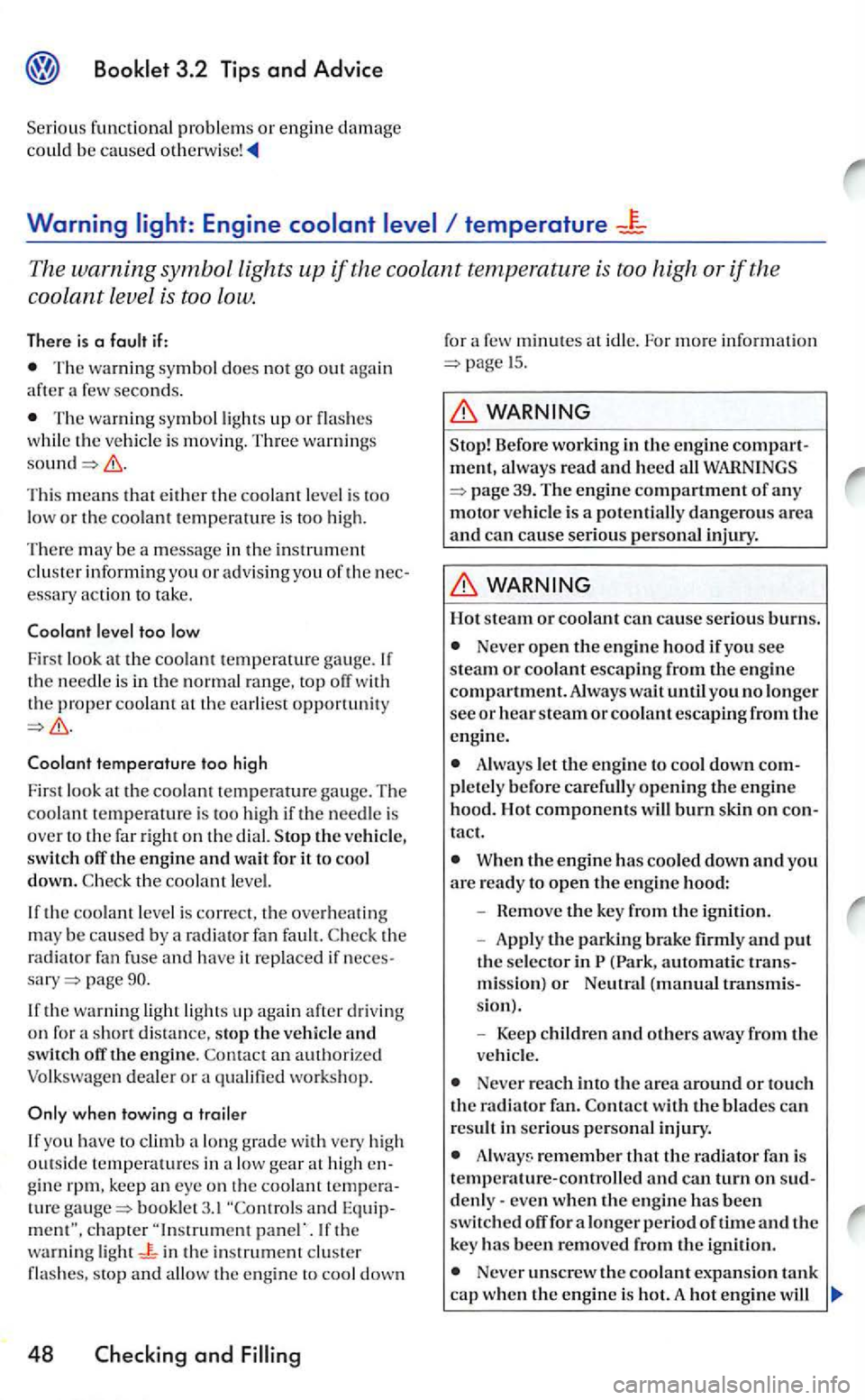
Booklet 3.2 Tips and Advice
functional problem s or engine damage could be caused
Warning temperature
The warning symbol lights up if the coolant temperatur e is too high or if the
coolant level is too
Low.
Ther e is a fault if:
The wa rnin g symbol does not go out aga in afte r a few seconds.
The wa rnin g symbol light s up or flas hes whil e the vehicle is moving. Three warning s
This means th at eith er th e coolant leve l is too low or the coo lant temperature is too high.
Th ere may be a m essage in the i
nstrument
clu ste r inf orming you or advi sing you of th e
Coolant temperature too high
Fir st look at the coolan t tempe rature gau ge. The coolant temperature is too hi gh if th e need le is
o ver to th e fa r right on the dial. the vehicle,
switc h the engine wait for it to cool down. the coo lant level.
I f th e coo lant level is co rrect, th e over heating may be caused by a radia tor fan fault. the ra diator fan fuse and have it replaced if page
If th e wa rnin g light lights up again after driving
o n for short distan ce, stop the vehicle switch otT th e e ngine. an authorized Volkswagen dea le r or a qu alified worksh op.
when towing a trailer
If you have to c limb a lo ng g rad e w ith high temperatures in low gea r at high gin e ture booklet 3. 1 and If th e
w arning light in th e in st rument cluster flas hes, stop and a llo w the e ngine to coo l down
48 Checking and Filling
for minutes at idl e. For more inform ation 15.
alw ays read and heed all
Hot steam or coolant ca n cause seriou s burns.
Neve r open the engine hood if you see steam or coolant escaping from the engine compartment. Always wait until you no longe r see or hear steam or coolant escaping from the
e n gine.
Always let the engine to cool down pl ete ly before carefully opening the engin e hood. Hot components will burn tact.
When the engine has coo led down and you are ready to open the engine hood:
-
move the key f rom the ignitio n.
- Appl y
the parking brake firmly and put the selector in ( Park, automatic mission) or Neutral (manual
Never reach into the area around or tou ch
th e rad iator fan. with the blades ca n
re sult in serio us personal injury.
remembe r th at the radiator fan is temperature-controlled and can turn on
fo r a longer p eriod of tim e and the
key has been r emoved fro m the ig nition.
Never unscrew the coola nt expansion tank cap when the e ngin e is hot. A hot engine will
Page 325 of 444
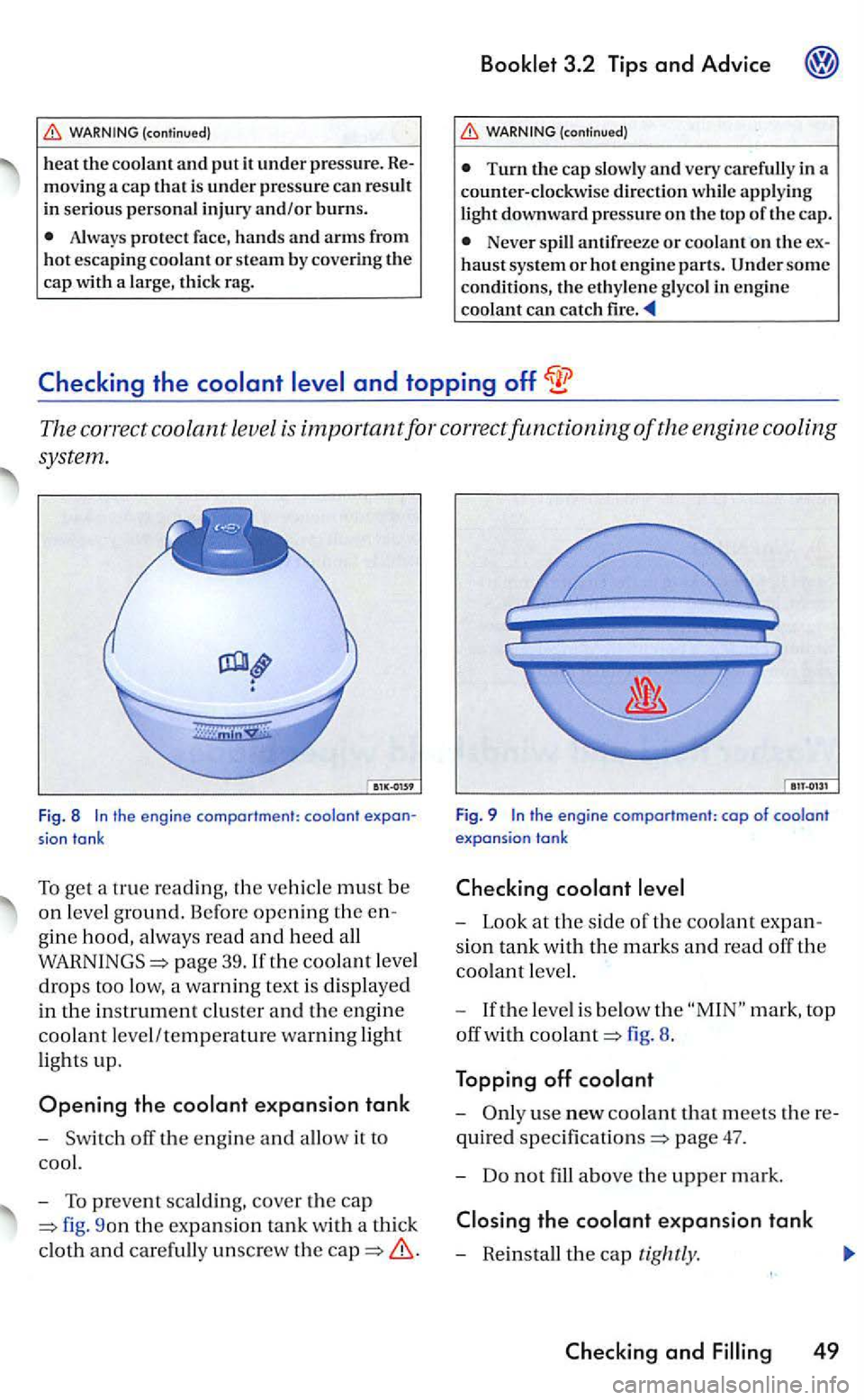
Always protect face, hands and arms from hot escaping coolant or steam by covering the cap with a large, thick rag.
(contin ued)
Turn th e cap slow ly and very carefully in a
counter-clockwise direction while applying
light
down ward pressure on the top of th e cap.
Never spill antifreeze or coolant on the haust system or hot eng ine parts. Under some conditions, the ethyle n e glyco l in en gin e
coolant can catch fire.
Checking the
The correct coolant level is important for correct functioning of the engine cooling
system.
Fig. 8 t h e engin e compartment: coolant
sian tank
To get a true reading, the ve hicle must be
on l eve l ground. Before opening the
gine hood, always read and heed all
page 39.1f the coolant level
drops too low, a warning text is displayed
in the in strument cluster and the engine
coolant leve l/temperature warning ligh t
lights up.
Opening the expansion tank
- Switch
9on the expansio n tank with a thick
cloth
and carefully unsc rew the
Fig. 9 the engine compartment: cap of coolant expansion tank
- Look at the side or the coolant
sion tank w ith the marks and read off the
coolant level.
-
If the level is below the mark, top
off wi
th fig. 8.
Topping off
-
the
and
Page 331 of 444
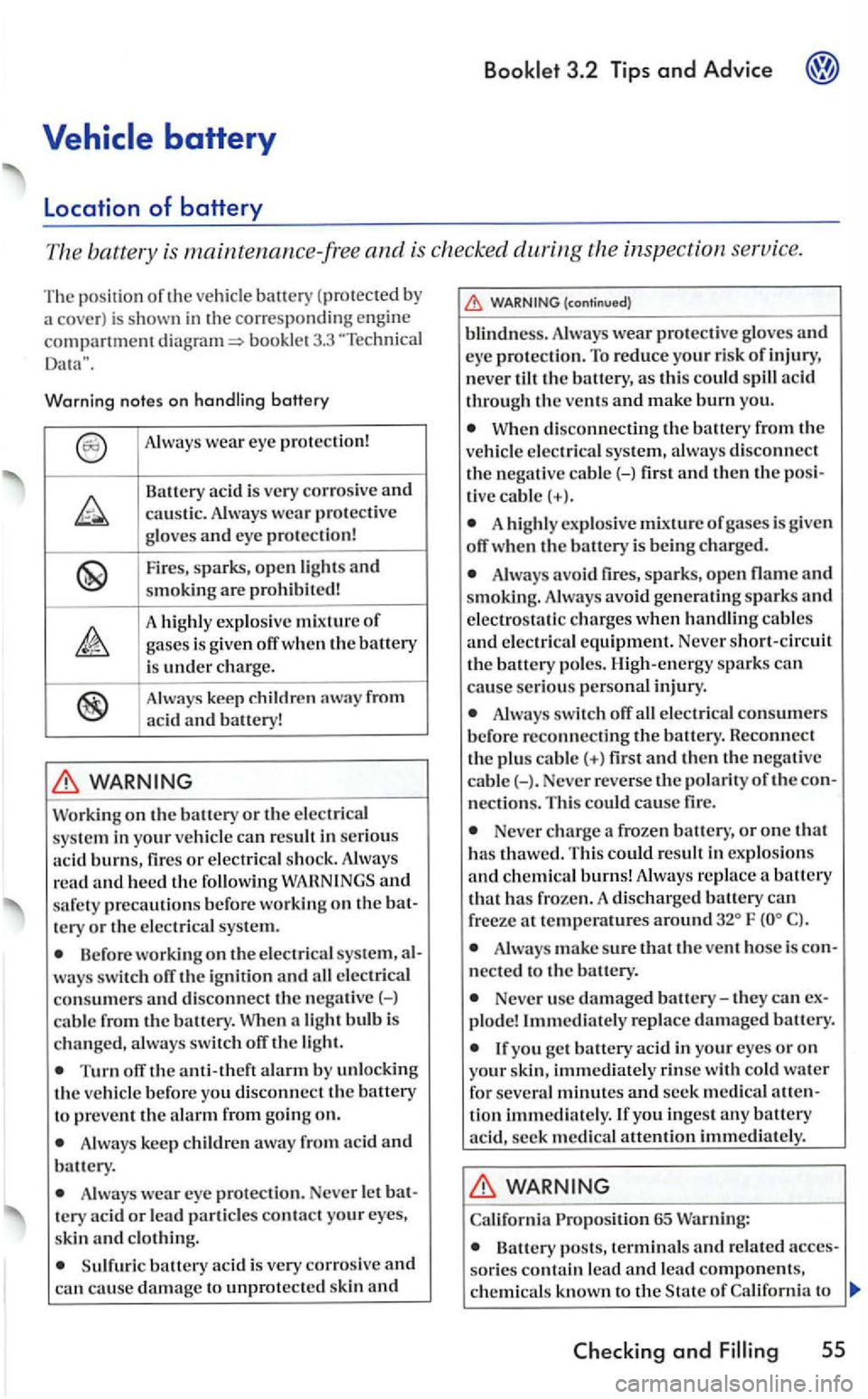
booklet 3.3 ""Technical
Warnin g notes on hand lin g battery
p ro tect ive
g loves an d eye protect ion!
Fir es, sparks, open lights and smoking are prohibi te d !
hi ghl y ex plo sive mixtu re of is give n off whe n the battery
i s under c h arge.
keep frn m
acid and battery !
WARNING
Working on the battery or th e e lectri ca l
sys tem in your vehicl e ca n res ult in serio us
acid burns, fires or elec tri ca l s hock . Always
read and heed th e follow ing W/\HN INGS and
safe ty preca utions before work ing on th e
Befo re wo rking o n th e electrica l system, ways switc h off the ignit ion and all elec trical
co nsumers and disconnect the nega tive(-) cabl e from the battery. When light bu lb is
changed, always switc h off th e light .
Turn ofT the anti-theft ala rm by unlockin g the vehicl e before you disconnect the ba ttery
to preve nt the from on.
A lway s kee p children
Always wear eye protection. Never let tery acid or lead particles contact your eyes ,
s ki n and clothing.
Sulfur ic battery aci d is ve ry corros ive and can cause damage to unp rot ected skin and
(continued)
blind ness. Always wear protective g loves an d
eye pro tectio n. To reduce your risk of injury, n ev e r tilt the battery, as thi s could spill acid
th ro ug h th e vents and m ake burn yo u.
W he n disconnec ting the ba tt ery fr o m the vehicl e electrica l sys te m , a lways disconnec t
th e nega tive cable(-) fir st and th en th e tive cable(+).
A hig hl y exp los ive mixtu re of is given
off w he n th e battery is being charged.
A lway s avoi d fires, sp a rk s, open and sm oki ng. Always avoid generati n g sparks and electros ta ti c ch arges when h andling cabl es
and e lec tric a l equipme nt . Neve r sh o rt -ci rc u it
th e ba tte ry po les. High-energy sp a rk s can
ca u
se serio us personal injury.
Alway s switch off all electri cal consumers befo re reconnec ting the batt ery. Recon nect
t h e plu s ca ble(+) first and then th e negat ive
cable(-). Never reve rse the po larity of the
Never ch arge
F C).
Alwa ys make su re that th e ve nt hose is nect e d to the battery.
Neve r usc dam age d battery-they can plode! Immed ia te ly rep la ce dam age d battery.
tion immediately. lfyo u in ges t any batt ery
a cid , seek medic al atte ntion immedia tely.
WARNING
Ca lifornia 65 Warning:
Battery posts, termina ls and re la ted sories con tai n lead a nd lea d compo ne n ts ,
c h em ica ls known to the
and
Page 332 of 444
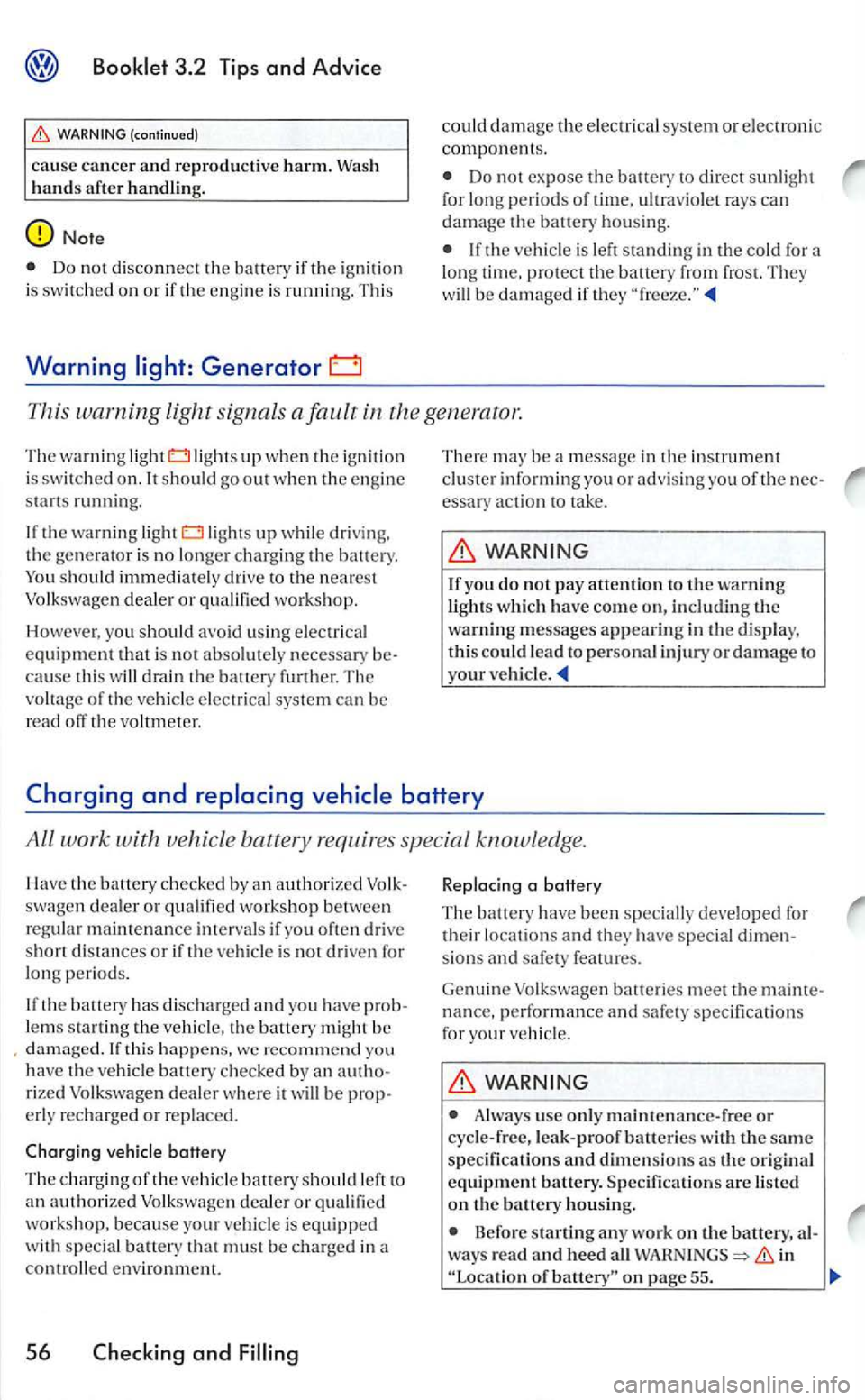
(continued)
cause cancer and reproductive harm. Wash
h ands afte r handling.
Do no t d isconnect th e battery if the ig nit io n
i s swit ch ed on or if the e ng in e is running. Thi s
Warning
could damage the e lectrical sys tem or electronic compon ents.
Do not expose the battery to direct sunlight
for long periods of tim e, ultrav io let rays can
damage the battery hous ing.
Thi s warning light sign als a fault in the generator.
The warning light lights up when the ign itio n
is sw itch ed on. should go out when the engin e
s ta rt s running.
the wa rning light lights up w hile driving.
t h e ge ne rator is no lon ger charg ing th e battery. should imme dia te ly driv e to the neare st
Volkswagen dealer or qu alified wo rk shop.
However, you should avo id usin g e lectrical equipment that is not absolu tely necessary because thi s
If yo u do not pay attentio n to the warnin g
li ghts which have come on, including the warning messages appearing in the display, th is could lead to personal injury or damage to your vehicl e_
Charging and
this we recommend you
h ave the ve hicle battery ch ecked by an authorize d Volkswage n dealer w here it be prop
erly recharged or re pl aced .
Chargin g ve hicle battery
Th e charging of the ve hicle battery should le ft to an authorize d Volkswage n deale r or qual ified
w orks hop. because your ve hicl e is equip pe d
wi th special ba tt ery that must be charged in a environment.
56 Checking and
A lways use onl y m aintenance-free or cycle -free , leak-proof batteries with the same specification s and d im en sio ns as the orig in al equipment battery- Specifi cations arc listed o n the battery ho using_
in of on page 55.